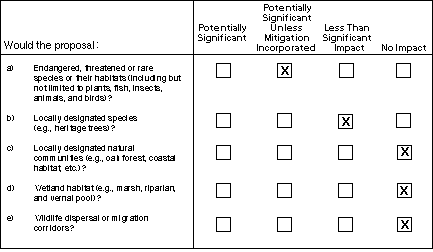
VII. BIOLOGICAL RESOURCES

The Monta Vista substation project area consists mainly of asphalt roadways in developed residential and commercial areas that do not provide habitat values for common or special status plant or wildlife species. Habitat for special status species, including the burrowing owl (Speotyto cunicularia; a federal and state species of special concern), does not occur in the upland developed areas outside of the paved project right-of-way. Therefore, no impacts to special status plant and wildlife species nor their habitats would occur from the facilities constructed in these developed areas. One segment of the proposed underground powerline is located near Heney Creek, a regionally-significant biological feature. California red-legged frogs (Rana aurora draytonii; a federal threatened species) are known to use riparian habitat and upland areas, and if present, could be adversely affected by project activities. Focused surveys of Heney Creek in 1997 and 1998 did not locate suitable habitat for California red-legged frog in the project vicinity, and no other special status species are expected in this waterway. The nearest described California red-legged frog occurrence is approximately 1.5 miles west of the Heney Creek crossing site in Permanente Creek. Based upon stream survey results, consultation with resource experts, and known species distribution data, it is unlikely that California red-legged frog habitat or individuals occur near the creek crossing, or would be adversely affected by the proposed project.
The project would have a low potential to impact nesting raptors in several project area trees, though no nests were observed during 1998 surveys. Raptors (birds of prey) and their nests are protected under the federal Migratory Bird Treaty Act. The presence of several large trees near the Monta Vista substation yard and the Santa Clara Valley Water District (SCVWD) laydown area near Heney Creek creates a low potential for raptors such as red-tailed hawk (Buteo jamaicensis) and red-shouldered hawk (B. lineatus) to nest in the project area. If present, activities conducted during the nesting season (March-July) could disturb nesting raptors. This impact would be potentially significant. If construction in raptor-sensitive areas is conducted entirely within the non-breeding season (August-February), no mitigation would be required. Otherwise, the applicant-proposed mitigation provided at the end of this section would reduce this impact to a less than significant level.
There are no locally-designated natural communities in or near the project right-of-way, and no impact would occur.
No wetland habitat would be affected by the proposed project and no impact would occur.
Much of the project area is paved and does not function as a wildlife dispersal or migration corridor. The proposed underground power line near Heney Creek and activities in the immediate creek area would not create barriers to or substantially alter wildlife dispersal or migration corridors.
Applicant Proposed Mitigation
The following mitigation measures proposed by PG&E would ensure that all impacts to biological resources resulting from the project would be less than significant:
Before the spring breeding season (early February) and within 30 days prior to construction, a survey of the construction area for raptors and their nests will be performed by a qualified biologist.
If avoidance of an active nest is not practicable (February to July), a buffer zone of 250 feet will be maintained for equipment and activities. If a nest is detected, a qualified biologist would be consulted to monitor nest activity. If nest disruptions or abandonment are noted, PG&E will consult with the California Department of Fish and Game and the U.S. Fish and Wildlife Service to determine any additional mitigation that may be required.
Any trees removed from SCVWD property would be replaced with native, low-growing species that are compatible with the powerline, and approved by the SCVWD. Suitable species include interior live oak and riparian species such as elderberry (Sambucus sp.) and red willow (Salix laevigata).
TOP
| Forward to Next Section (Energy and Mineral Resources) |
Back to Previous Section (Transportation and Circulation) |
Back to Monta Vista/Wolfe/Stelling Looping Project Main Page | CPUC Environmental Page | CPUC Home Page |